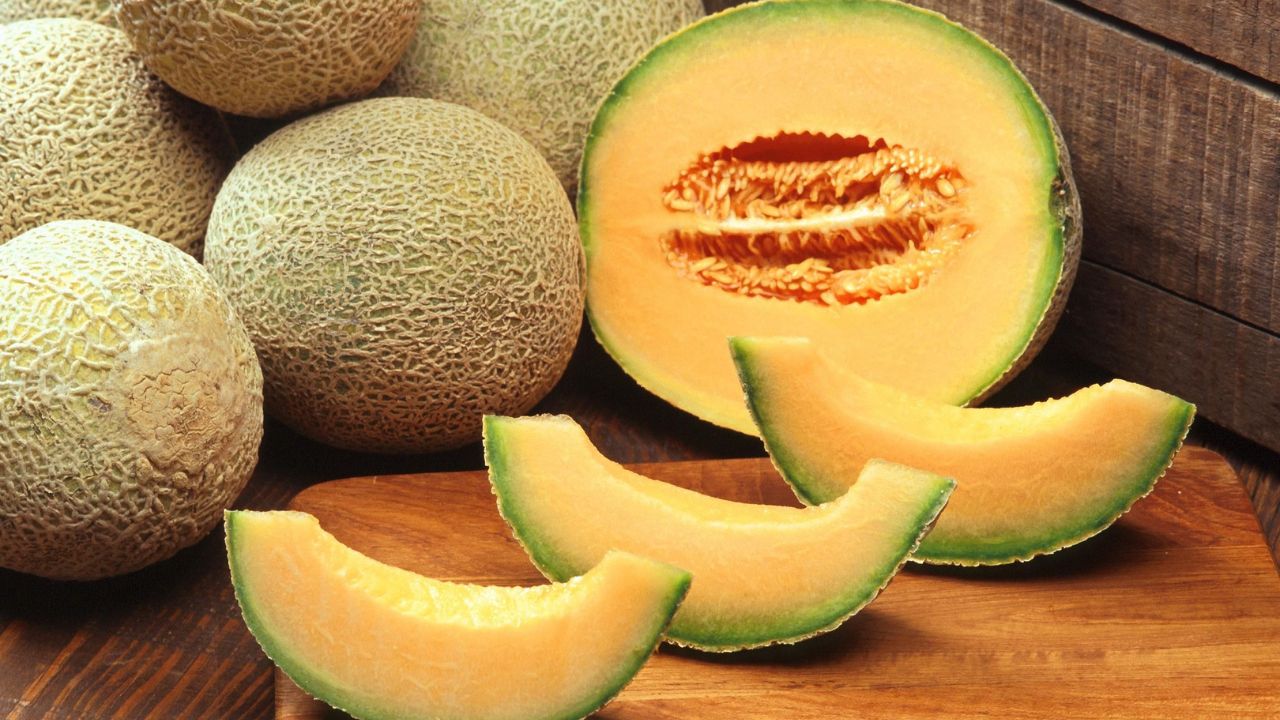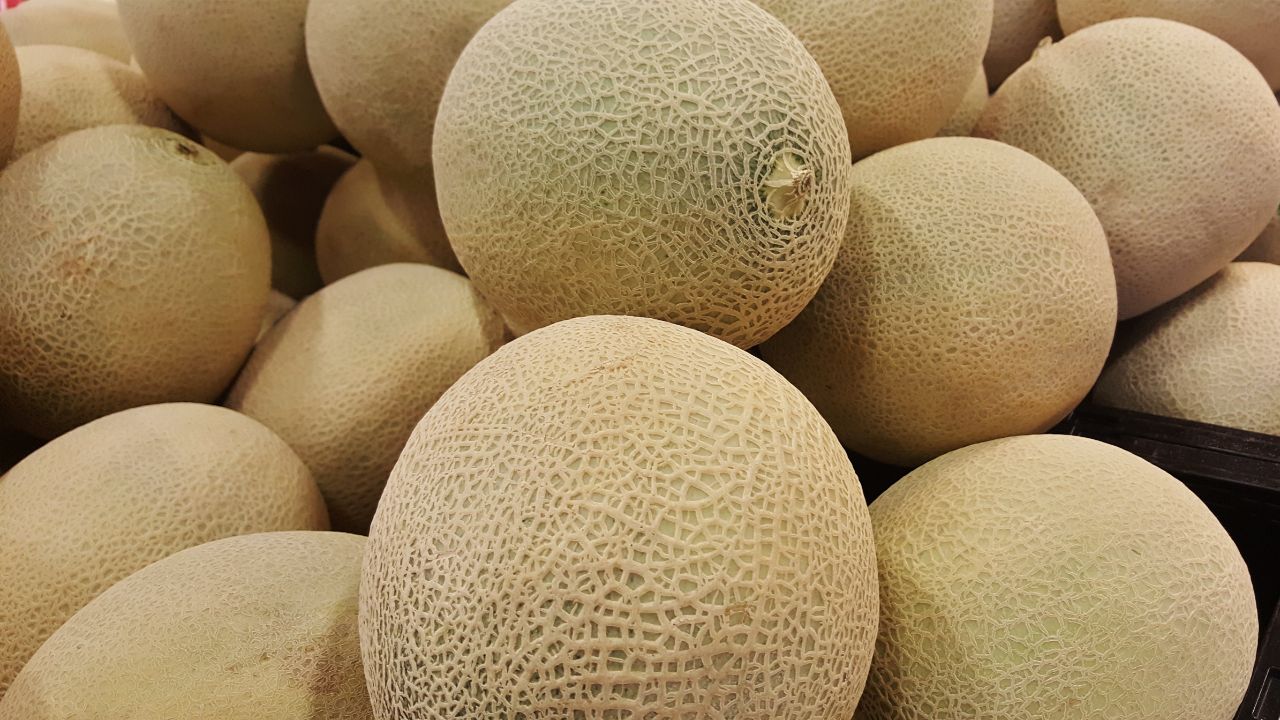The humble cantaloupe is a fruit that’s often overlooked by the world. Despite this, they are still delicious, sweet, and so succulent – when you pick the right one.
Don’t be the person who overlooks this melon (see also ‘Pepino Melon: Taste And How To Eat It‘). Maybe you had a bad experience with one when you were a kid, but it’s time you face it. If you can choose the right cantaloupe, there is nothing more delicious.
The taste isn’t the only appealing thing about it, either! These fruits are beautiful inside and out, smell incredible, and are packed full of vitamins and water.

Picking The Perfect Cantaloupe At The Store
A ripe cantaloupe is delightful, but an unripe fruit is less than pleasant. When you find yourself with an unripe cantaloupe, you will get bitter or bland flesh that is tough and unpleasant.
Making the right choice when you buy is so important – a cantaloupe won’t ripen any further once it’s been picked! Because of this, you need to know what to look for when you’re searching for one to purchase.
Take your time, and consider the following things before you finalize your choice:
The Shape
A good cantaloupe should be beautifully round or oblong. If you notice any dents or punctures, you should leave that cantaloupe alone.
Although nothing in nature is really perfectly symmetrical, avoid cantaloupes that are obviously asymmetrical. You might still get a tasty cantaloupe, but it’s sometimes a sign that something isn’t quite right.
The Weight
Look for a cantaloupe that feels heavy for its size. A weighty cantaloupe is usually a good cantaloupe and tells you that the insides haven’t shriveled up.
If your cantaloupe feels very light, then there’s a very good chance that it is an old fruit and not a great option. The flesh inside is likely to be dry and flavorless – a waste of money!
You can check to see how hollow the fruit is by gently tapping on it – that will reveal everything you need to know.
Check For Bruising Or Discoloration
Any healthy cantaloupe shouldn’t have any discoloration on it. If you notice brown or black markings, the fruit is likely to be bruised. This can impact the flavor and texture of the flesh – not something we want!
With that being said, it’s perfectly normal for a cantaloupe to have a whitish discoloration on the rind. This mark is just from the fruit resting on the ground, and it won’t impact it in any way.
Look For Insects And Fruit Flies
Finally, look out for insects or fruit flies! These equal decay, so stay away! Find a cantaloupe that doesn’t seem to be attracting all the bugs, and it won’t be rotten.
How Will You Know If A Cantaloupe Is Ripe?
Ripeness is key when you’re wandering the grocery store. There is no way for a cantaloupe to continue ripening when it’s been picked, so be careful and make good choices.
We will go through a few things you need to consider when you’re trying to look for the perfectly ripe cantaloupe.
Don’t worry if you look a little crazy when you’re doing this. While other shoppers rush around and pick up unripe fruit, you will get the perfect pick. It’s their loss.
A Webbed Pattern Appearance
First thing’s first – the appearance. A ripe cantaloupe will have beautiful web-like patterns on the surface. These markings will be beige and be a series of raised ridges.
The visible areas between the netting should be either sandy gold, tan, yellow, or cream-colored. If you notice that the fruit still looks very gray, then it isn’t ripe, and you should steer clear.
Check The Stem
More specifically, check where the stem would have been. If a cantaloupe is ripe for the picking, it will detach from the stem very easily.
As such, where the stem was, there should be a perfectly clean depression that is no more than a small indent. It should be smooth and barely noticeable.
If you notice that a cantaloupe has some stem protruding, stay away from it. Any kind of stem remnant is a clear sign that the fruit was harvested too early and definitely isn’t ripe.
It’s worth noting that you should be careful when handling cantaloupes. If you aren’t expecting there to be any rough stems still attached to the fruit, you can easily hurt yourself or others.
Handle the fruit with care and gently check for any stem remnants rather than picking it up blindly.
How Does It Sound?
Hollows are a no-go. If you can tap the cantaloupe, and it sounds hollow inside, you can put it back and continue your search. Tapping the fruit should result in a low, deep sound from within.
Take the time to do this properly to every melon you think of bringing home. This trick works on most, if not all melons, so try it out for other varieties, too!
What Does It Smell Like?
Get up close and personal with the melon and give the blossom end a good sniff. That’s the end that is opposite to the stem-end, if you weren’t sure.
A ripe cantaloupe will have a delightful musky aroma mixed with some floral sweetness. It’s one of the best smells out there and always a good indicator of a ripe or unripe melon (see also our article on winter melons).
If you sniff a cantaloupe’s blossom end and notice nothing – it isn’t ripe! An unripe cantaloupe will either have no smell, or a very faint one. In either case, put it back and look for one that has a sweet and musky smell.
An overripe cantaloupe might smell like acetone or alcohol – this indicates that it’s started to ferment. Avoid it at all costs because it will taste foul.
Consider The Feel
Finally, consider how the cantaloupe feels. It is happy – just kidding. A ripe cantaloupe will have the perfect firmness. It won’t be rock hard, but it won’t be soft, either.
It should be somewhere in between. You can test this by gently pressing down on the end where the stem would have been. It should give under the weight of your finger just a little.
If the fruit doesn’t give at all, even with a decent amount of pressure, put it back! Remember – it won’t ripen anymore. If you notice that a little pressure results in the fruit caving in under your finger, it is too ripe and way past its prime.
You can also give the fruit a decent shake to see if you can hear or feel any seeds rattling around. If you do, it’s a good sign! However, if you don’t feel any movement, then you can put the fruit back and move onto your next target.

Proper Cantaloupe Storage
There’s no point in going through all the effort to find a decent cantaloupe only to store it incorrectly! Let’s go through everything you need to know about proper cantaloupe storage below.
Storing An Unripe Cantaloupe
If you’re in this position, our condolences. While you will never get the sweet and succulent fruit you were hoping for, you can at least soften the flesh. All you need to do is leave the fruit at room temperature for a couple of days to help it soften. Keep it in a paper bag to try and speed things up if you want.
Just bear in mind that the flavor won’t change.
Storing A Whole Cantaloupe
A whole cantaloupe will be perfectly fine for up to five days if you just leave it out at room temperature on the counter.
However, if you’re planning on keeping the fruit around for a while, the best thing to do is place it in your refrigerator. There, it can be stored for a week, if not longer.
Ensure that the temperature inside the fridge isn’t too cold, though. Keep the temperature somewhere between 36-40 degrees Fahrenheit to ensure maximum freshness.
Any warmer and it may start to deteriorate, and and colder, and it might freeze!
Storing A Sliced Cantaloupe
You should wrap up the main body of the fruit in plastic wrap and keep it in the refrigerator. For the slices, keep them in an airtight container and keep them in the fridge, too.
Ensuring the fruit is covered is crucial, as cantaloupes will absorb flavors from the foods around them – no one wants a cheese-tasting cantaloupe!
You should also keep the seeds on the fruit, as they will help the cantaloupe keep its moisture. If you have sliced a cantaloupe and left it out for two or more hours, don’t eat it. They will quickly become unsafe, so just throw them away.
It’s also recommended to rinse a cantaloupe before you slice into it (not in advance). There could be harmful bacteria sitting on the rind, which could pass through to the flesh. Washing it in advance can cause mold growth, so don’t do that!
Final Thoughts
And there you have it! Everything you need to know about cantaloupes, including how to pick the perfect one and store it properly.
Cantaloupes are delicious fruit, but only when they’re ripe. Because of this, it’s worth taking the extra time to find the perfect fruit before making your final decision. Good luck picking!
- 15 Traditional Greek Breads - July 31, 2023
- 30 Delicious And Gluten-Free Cookie Recipes - July 29, 2023
- 30 Of The Best European Desserts - July 29, 2023
